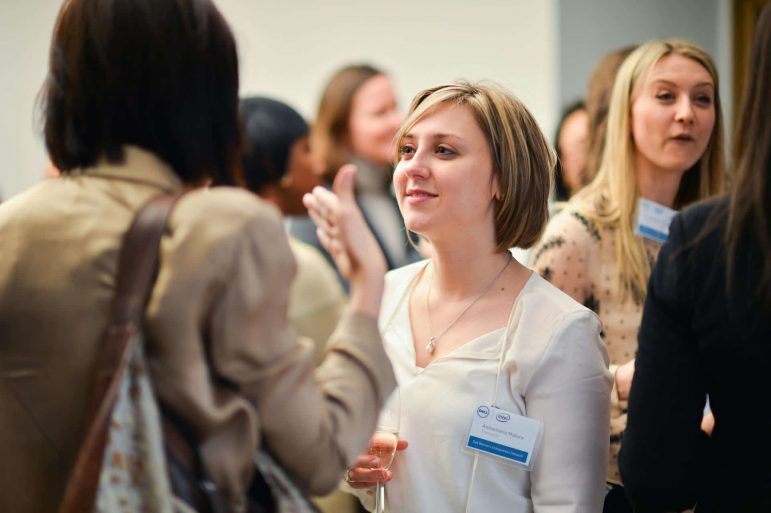Luckily I made it to the check in table just in time to catch other stragglers receiving their workshop materials.
Bob Lujano, a summit participant checks in: “Yeah, so I’m Bob Lujano, replacing Kevin Orr with Lakeshore Foundation.”
I follow Lujano into the large ballroom where Dr. Tim Alford, Director of Alabama’s office of workforce development, is speaking:
“What you’re going to do over the next 2 days is look at your organizational self-interests, look at, in our lexicon, we look at, where you’d like to be as a community and where you are now and how you get from where you are to where you’d like to be.”
Where we are as a community is what the organizers of this summit like to call activities rich/systems poor. Meaning, that although there are a large number and wide range of services aimed at developing the youth of Jefferson county into an educated and productive workforce, there is no overarching system of cooperation, collaboration, referral, or networking among the hundreds of educational, social, government, non-profit, and business organizations. The problem with this lack of communication, say organizers, is that it affects the efficiency and quality of services being provided: services like literacy counseling, GED preparation, and vocational training.
Money is also an issue. Jefferson County’s Center for Workforce Development, which provides job placement and other career training services can only afford to serve 1500 of the county’s 23,000 eligible youth. Center directors have no idea what becomes of the thousands of youth they can’t accommodate.
Some of these youth likely end up in the YWCA’s “If I had A Hammer” program, which helps young mothers earn their GEDs and gain work experience in the construction industry. The program’s director, Jennifer Clammir explains why she believes inter-organizational cooperation is so important when dealing with youth issues:
“One of the issues you have with young adults is that they need a lot of different things to help them get from point A to point B and we can only do so many things well. So we have a GED program but a lot of our young women need more skill readiness. So working collaboratively with community colleges like Jeff state they can go to evening classes and get their GED within 6 months as opposed to 3 years.”
Judging by the size of the crowd at the booked-to-capacity conference, most organization leaders agree with Clammir: at least in theory. But getting non-profits to collaborate can be trickier than it sounds when it might mean having to share precious funding sources. Buzz Schmidt, founder of Philanthropic Research Incorporated explains:
“This will sound ironic, but there’s often a competitiveness among nonprofits that would never exist with for-profits. The for-profits would have more reason and more knowledge to seek more efficient collaborations.”
With all the talk from the adults at the summit about how Alabama schools are failing to prepare students for college, jobs, and life in general, I decided to find out what the students themselves had to say. At Western Hills Mall I met local high-schoolers Kendal Taylor and Tony Smith.
“Yeah, I plan to go to Tennessee State, major in computer engineering.” Taylor says.
Smith adds, “Plan on going to the Air Force. Just getting my degree a little quicker than going to college, then they pay for college too.”
And then there’s Mark House, a native of Fairfield, who graduated from Vanderbilt University in 2003 with a business degree and is currently aiming for law school. House’s story would appear to be the American dream come true: rising from humble circumstances and earning a football scholarship. There’s only one problem. As House puts it:
“I don’t have a job. I never thought I’d be cutting hair after graduating from a prestigious university such as Vanderbilt.”
The Boston-based School and Main organization facilitates summits like this one in communities around the country.
In fact, attendees at the youth development summit do have their work cut out for them.
According to the Manhattan Institute, Alabama has an overall high school graduation rate of 66%, making it 37th in the nation. The Alabama Policy Institute reports that colleges and universities alone spend $85 million a year on remedial education while statewide, businesses somewhere in the ballpark of $300 to $450 million a year retraining an inadequately prepared workforce. Even those students who do make it through high school and college are often ill prepared to join a skilled labor force.
But can Birmingham area businesses, educational centers, health practitioners, social service providers, government offices, and non-profits really agree to put aside their differences and self-interests in order to better serve the youth whom they intend to train into economically and socially valuable young adults? Patrick Winters is executive director of Jefferson County’s Center for Workforce development and co-organizer of the summit.
“Once the summit is done we will publish a report and all the individuals here will be assigned to action teams to work on various parts of the report,” he says.
Winters plans to hold another summit a year from now so that the community can evaluate its progress and continue to work towards the common goal of youth workforce development.

